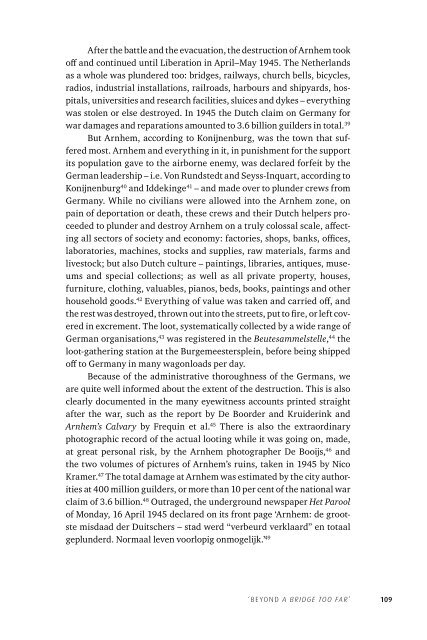Discord Consensus
7aze300jFJo
7aze300jFJo
Create successful ePaper yourself
Turn your PDF publications into a flip-book with our unique Google optimized e-Paper software.
After the battle and the evacuation, the destruction of Arnhem took<br />
off and continued until Liberation in April–May 1945. The Netherlands<br />
as a whole was plundered too: bridges, railways, church bells, bicycles,<br />
radios, industrial installations, railroads, harbours and shipyards, hospitals,<br />
universities and research facilities, sluices and dykes –everything<br />
was stolen or else destroyed. In 1945 the Dutch claim on Germany for<br />
war damages and reparations amounted to 3.6 billion guilders in total. 39<br />
But Arnhem, according to Konijnenburg, was the town that suffered<br />
most. Arnhem and everything in it, in punishment for the support<br />
its population gave to the airborne enemy, was declared forfeit by the<br />
German leadership – i.e. Von Rundstedt and Seyss-Inquart, according to<br />
Konijnenburg 40 and Iddekinge 41 –and made over to plunder crews from<br />
Germany. While no civilians were allowed into the Arnhem zone, on<br />
pain of deportation or death, these crews and their Dutch helpers proceeded<br />
to plunder and destroy Arnhem on a truly colossal scale, affecting<br />
all sectors of society and economy: factories, shops, banks, offices,<br />
laboratories, machines, stocks and supplies, raw materials, farms and<br />
livestock; but also Dutch culture –paintings, libraries, antiques, museums<br />
and special collections; as well as all private property, houses,<br />
furniture, clothing, valuables, pianos, beds, books, paintings and other<br />
household goods. 42 Everything of value was taken and carried off, and<br />
the rest was destroyed, thrown out into the streets, put to fire, or left covered<br />
in excrement. The loot, systematically collected by a wide range of<br />
German organisations, 43 was registered in the Beutesammelstelle, 44 the<br />
loot-gathering station at the Burgemeestersplein, before being shipped<br />
off to Germany in many wagonloads per day.<br />
Because of the administrative thoroughness of the Germans, we<br />
are quite well informed about the extent of the destruction. This is also<br />
clearly documented in the many eyewitness accounts printed straight<br />
after the war, such as the report by De Boorder and Kruiderink and<br />
Arnhem’s Calvary by Frequin et al. 45 There is also the extraordinary<br />
photographic record of the actual looting while it was going on, made,<br />
at great personal risk, by the Arnhem photographer De Booijs, 46 and<br />
the two volumes of pictures of Arnhem’s ruins, taken in 1945 by Nico<br />
Kramer. 47 The total damage at Arnhem was estimated by the city authorities<br />
at 400 million guilders, or more than 10 per cent of the national war<br />
claim of 3.6 billion. 48 Outraged, the underground newspaper Het Parool<br />
of Monday, 16 April 1945 declared on its front page ‘Arnhem: de grootste<br />
misdaad der Duitschers –stad werd “verbeurd verklaard” en totaal<br />
geplunderd. Normaal leven voorlopig onmogelijk.’ 49<br />
‘BEYOND A BRIDGE TOO FAR’<br />
109


